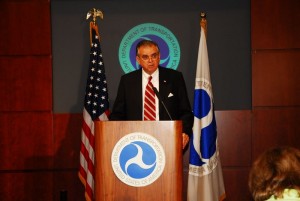U.S. Transportation Secretary Ray LaHood has announced a summit meeting next month to “address the dangers of text-messaging and other distractions behind the wheel.”
In late September, senior transportation officials, elected officials, safety advocates, law enforcement representatives and academics will convene in Washington, DC to discuss ideas about how to combat distracted driving.
The summit appears to be a response to charges that the Department of Transportation, the government agency responsible for traffic safety, has been suppressing studies showing just how bad the problem is, and, worse, for bowing to Congressional pressure not to pursue regulations that would save lives.
But once again the announcement skirts the core safety issue, cell phone use, which produces accident rates the equivalent of drunk driving.
Public Citizen and the Center for Auto Safety have charged that since 2003, the government has known that drivers talking on their cell phones experience the same potentially deadly distraction whether they are using a handheld device or hands-free technology. The pressure groups made the accusations after a lawsuit under the Freedom of Information Act obtained internal documents from the National Highway Traffic Safety Administration, which is part of DOT.
The suppressed evidence and opinions by safety experts advising NHTSA have since been confirmed by numerous independent studies.
“If it were up to me, I would ban drivers from texting, but unfortunately, laws aren’t always enough,” said LaHood. “We’ve learned from past safety awareness campaigns that it takes a coordinated strategy combining education and enforcement to get results. That’s why this meeting with experienced officials, experts and law enforcement will be such a crucial first step in our efforts to put an end to distracted driving.”
According to DOT, several deadly accidents involving text messaging behind the wheel have called attention to the dangerous problem of distracted driving. Last year, a commuter train crash in California involving an engineer who was texting on a cell phone killed 25 people and injured 135 others. In another incident, a Florida truck driver admitted to texting moments before a collision with a school bus that killed a student. In yet another, only a few weeks ago, a 17-year-old high school student from Peoria, Illinois was killed when she drove off the road while texting with friends. Peoria is LaHood’s home town.
Added Secretary LaHood, “The bottom line is, distracted driving is dangerous driving. Following next month’s summit, I plan to announce a list of concrete steps we will take to make drivers think twice about taking their eyes off the road for any reason.”
The omission of cell phone use from the official announcement will become a problem if data are honestly discussed at the summit. It is estimated that more than 100 million people each day are practicing dangerous distracted driving behavior.
Especially deadly is the widespread use of cell phones. The problem is not the type of phone a driver uses, rather it is the distraction caused by the conversation itself. That’s the reason the National Safety Council called for a total ban on using cell phones while driving earlier this year after conducting studies that confirmed previous research on just how dangerous cell phones are.
NSC said cell phone use while driving contributes to 6% of crashes, or 636,000 wrecks, 330,000 injuries, 12,000 serious injuries, and 2,600 deaths each year. NSC estimates the annual financial toll of cell phone-related crashes at $43 billion. Simply put, cell phone use is as dangerous as drunken driving.
Senate Democrats last week proposed a bill against texting while driving that, if enacted, would require that Transportation Department regulators to impose minimum penalties for states to implement against the offending drivers. States would have two years to enact their own laws.
At least thirteen states and the District of Columbia already have driver-texting bans in force or proposed. But this anti-texting movement fails to address the core issue — cell phone use, which might be too ingrained in the voting population for politicians to address, particularly at the local level.
Even LaHood acknowledges the cell phone problem. In a blog posting yesterday he wrote: “The bottom line is, we need to put an end to unsafe cell phone use, typing on blackberries and other activities that require drivers to take their eyes off the road and their focus away from driving.”
For information and updates on next month’s summit on distracted driving, click here.



Some where along the road getting from point A to point B went from an enjoyable driving experience to an enhanced entertainment/communications fiasco.
Searching for the right CD, adjusting the sub woofer, choosing the correct playlist on your Ipod, calling home, answering the text, changing the DVD for the kids, is there any doubt there are more accidents from distractions? Who has time for the road?
Big problem, once the lawmakers are involved you can bet we will go from one extreme to the other.